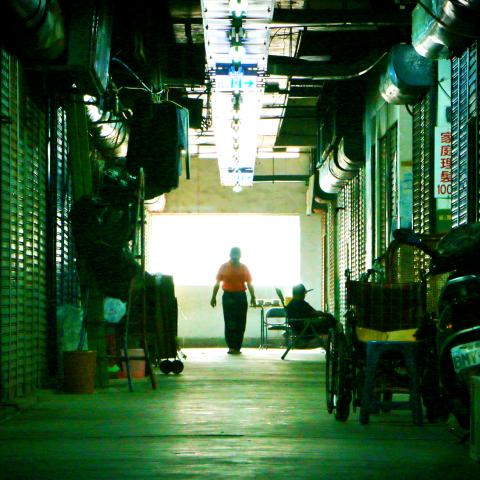When Tyson Skriver moved to Hsinchu three years ago, he explored the city with his camera. But it wasn’t until he attended a photo walk in Taipei’s dilapidated Nanjichang community (南機場) earlier this year that he was reminded of how much he enjoyed events with a deeper significance: Nanjichang has been trying to revitalize itself through numerous urban renewal projects such as community gardens and barista training for high school dropouts.
Skriver eventually organized a photo walk of his own in Hsinchu after some prompting from a friend. The Hsinchu photo walk, which takes places on Sunday beginning at 1:30pm, will introduce participants to the history of the 300-year old “Windy City.”
Starting at Hsinchu Train Station (新竹火車站), it will cover attractions including the Hsinchu Moat (新竹護城河) and City God Temple (城隍廟), which, according to Skriver, “is an excellent spot to grab a quick bite to eat and snap photos of the crowds pushing their way through.”

Photo courtesy of Tyson Skriver
Also along the route are lesser-known locations such as Dongmen Market (東門市場) and the historic Lane 36 on Dongqian St (東前街36巷), dubbed “Dark Street” since little light seeps through the compact, narrow buildings. The tiny street is also the birthplace of modern-day Hsinchu, founded in 1711 by a settler from China’s Fujian province.
Though the Hsinchu Moat, which boasts the title of being the last remaining moat in Taiwan, has drawn more visitors over the years, the Dark Street seems have to been largely neglected and forgotten.
“Only a small wooden sign above the lane indicates its age and significance,” Skriver says.
In addition to learning some history and honing one’s photography skills, the walk will also be a good opportunity to meet other people who are also interested in photography.
Skriver says photo walks are becoming more popular in Taiwan for this reason — though it’s easy to share and “like” photos on social media platforms such as Instagram, there is no face-to-face interaction. Photo walks fill that void.
He adds that it’s always interesting to see what different photographers decide to focus on as it provides a window into how they interpret the world around them. For instance, while some might choose to photograph beautiful flower petals set against a dilapidated building, others might choose to focus on the rust on the building’s facade.
“If you want to see the world through someone else’s perspective, take a look at their photos,” Skriver says.
If you plan on attending, in addition to a camera, remember to bring some sunscreen.

On April 26, The Lancet published a letter from two doctors at Taichung-based China Medical University Hospital (CMUH) warning that “Taiwan’s Health Care System is on the Brink of Collapse.” The authors said that “Years of policy inaction and mismanagement of resources have led to the National Health Insurance system operating under unsustainable conditions.” The pushback was immediate. Errors in the paper were quickly identified and publicized, to discredit the authors (the hospital apologized). CNA reported that CMUH said the letter described Taiwan in 2021 as having 62 nurses per 10,000 people, when the correct number was 78 nurses per 10,000

As we live longer, our risk of cognitive impairment is increasing. How can we delay the onset of symptoms? Do we have to give up every indulgence or can small changes make a difference? We asked neurologists for tips on how to keep our brains healthy for life. TAKE CARE OF YOUR HEALTH “All of the sensible things that apply to bodily health apply to brain health,” says Suzanne O’Sullivan, a consultant in neurology at the National Hospital for Neurology and Neurosurgery in London, and the author of The Age of Diagnosis. “When you’re 20, you can get away with absolute

May 5 to May 11 What started out as friction between Taiwanese students at Taichung First High School and a Japanese head cook escalated dramatically over the first two weeks of May 1927. It began on April 30 when the cook’s wife knew that lotus starch used in that night’s dinner had rat feces in it, but failed to inform staff until the meal was already prepared. The students believed that her silence was intentional, and filed a complaint. The school’s Japanese administrators sided with the cook’s family, dismissing the students as troublemakers and clamping down on their freedoms — with

As Donald Trump’s executive order in March led to the shuttering of Voice of America (VOA) — the global broadcaster whose roots date back to the fight against Nazi propaganda — he quickly attracted support from figures not used to aligning themselves with any US administration. Trump had ordered the US Agency for Global Media, the federal agency that funds VOA and other groups promoting independent journalism overseas, to be “eliminated to the maximum extent consistent with applicable law.” The decision suddenly halted programming in 49 languages to more than 425 million people. In Moscow, Margarita Simonyan, the hardline editor-in-chief of the